Introduction
Aliens: Fireteam Elite is a cooperative third-person survival shooter launched on August 24, 2021.
Aliens: Colonial Marines is a first-person action shooter launched on February 12, 2013.
Both games are based on the 1986 movie directed by James Cameron.
Note: Much of the text below has been edited for proper reading.
From YouTuber Nick930:
We’re going to take a special early look at Cold Iron Studio’s upcoming cooperative shooter game Aliens: Fireteam Elite and see how it stacks up in its current state to the infamous 2013 shooter from the Gearbox software Aliens: Colonial Marines. For this video, both games are being played on a PC and their graphic settings are ranked up to High at a native 4k resolution. However, I want to stress beforehand that the footage of the Fireteam Elite shown is from an early build of the game. Because of this, I’ll save my deep dive into the game’s graphics for a video closer to the official launch and focus today’s video primarily on the core aspects like the story delivery, the visual style, the gameplay design, and other miscellaneous features I feel are worth mentioning. Also, I want to thank Cold Iron Studios for inviting us out to try the game early.
Aliens: Colonial Marines Review Pros and Cons
From YouTuber Nick930:
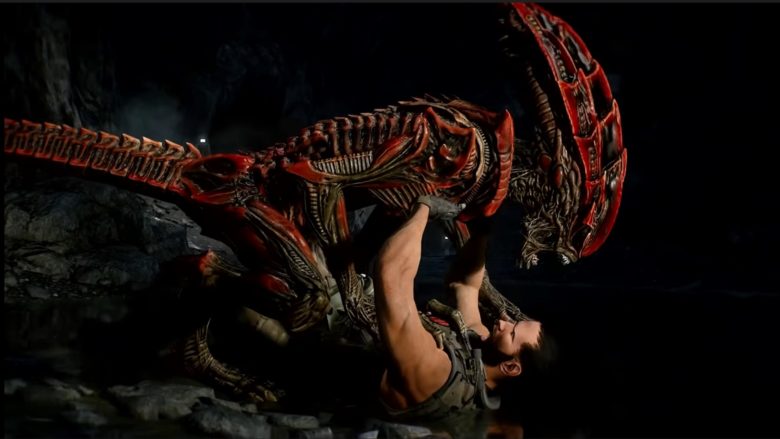
Alright, let’s get started by first talking about how each game handles its respective narratives. Aliens: Colonial Marines serve as a direct sequel to James Cameron’s 1986 classic Aliens. In it, players assumed the role of a corporal and a battalion of marines who were sent to investigate the events that transpired during the film. Soon after arriving, though, they’re brought face-to-face with a xenomorphic infestation and as you’d expect are picked off one by one in their efforts to search for survivors and escape with their lives.
They’ll run into several references to the film including recreations of iconic locations, similar scenarios, and even some familiar faces. Colonial Marines also borrows heavily from the very scripted first-person shooter design of games from the late 2000s, mainly the Call of Duty series. Every mission funnels the player through one-way paths often bookended by some sort of triggered event; whether that be an enemy ambush, a cheesy conversation, or some explosion off in the background. Because everything is set up this way, every player’s experience through the course of the game will be the same fireteam elite. On the other hand, it takes a much more distant approach to its storytelling.
This game takes place within the same universe but long after the events of the first three films. This means there are no cameos and no returning locations. It’s also unclear whether this game is considered canon to the main alien series like Colonial Marines is as far as the structure goes. Fireteam Elite delivers its narrative through audio recording logs and conversations with friendly NPCs back at its hub. The NPCs in this hub are fully voiced, however, it appears they have no talking animations in this early build. There are also no cut scenes, although it’s unclear if this will be added in later when actually on a mission fighting the xenomorphs themselves. There’s little to no story going on for sure.
There’s some radio communication with HQ repeatedly telling you where to go next but there’s no chatter between the player characters themselves to help expand upon their relationships. It’s similar to how the story is handled in the Destiny series where you can learn more about the game world and characters if you search for it and talk to all the NPCs, but it’s not explicitly told otherwise putting its cooperative gameplay above all else. This isn’t necessarily a problem. But I feel like this game should take a page from Turtle Rock and Valve’s Left For Dead series where the story is told through the environment and the several variations of the playable character dialogue triggered throughout each mission. The way it stands now feels weirdly disconnected, almost like an arcade shooter instead.
Next up, let’s talk about the visual style utilized by both games. It’s no mystery that Aliens: Colonial Marines is a bit of a train wreck of a game. It was hugely panned by critics and fans alike when it was first released due to its failure to deliver on promises, the most apparent of those being the lackluster presentation. The graphics were badly outdated at launch with low-resolution textures, broken artificial intelligence, and an abundance of annoying bugs primarily on the console platforms.
I have to say the game isn’t quite as terrible as I had anticipated.
That being said having just played this game for the first time this weekend, I have to say the game isn’t quite as terrible as I had anticipated. I still don’t recommend it but there’s a handful of moments here where I think the developers deserve some credit. They nailed the design of these environments at times with some nice attention to detail that feels like it’s ripped straight from the film. Some scenes are especially striking thanks to the smart use of ambient lighting to help set that quintessential Alien mood. Fast-forward to 2021, and we have Fire Team Elite that while not the worst-looking game, feels empty and uninspired; it’s just a bunch of hallways, staircases, catwalks, and more hallways.
I think mixing in residential areas, mess hall restrooms, or anything else would help to give these 15 to 20-minute sections of the game more life and help deliver a story without having to say a word. Now, that being said, the areas that are in the game are still very nicely detailed; the textures are nice and high quality, there are some great lighting effects, and I love the use of smoke and steam that will trigger at set moments, even if the effect itself doesn’t seem to play well at high refresh rates.
Still, an industrial location like this only stays interesting to the player for so long and it’s difficult to recall any particular area very well after the fact. The Xenos also don’t seem to be taking advantage of the space either considering the massive size of the swarms in-game. You’d expect to at least see some areas with alien eggs or at least that gross alien residue that forms hardened cave networks like in colonial marines and in the movies, but I’ve yet to see any of that. In fact, I never once ran into any face-huggers, chest busters, or eggs at all, which is strange to exclude entirely from the first quarter of an Aliens game.
Another problem I have with Fire Team Elite’s design is its overall brightness. The game seems to be in a persistent state of maximum power all the time, robbing it of any semblance of horror typically associated with the property. Colonial Marines had a much darker atmosphere, with some areas requiring frequent use of the torchlight to see aliens that will blend in the shadows, and you feel like you need to be careful searching around the room for them at times.
In Fire Team Elite, it’s 100 actions from start to finish. There’s no tension-building darkness, no strobe lights, no real need for a flashlight at all. Each hall is brightly lit and the only scares will come from the occasional unexpected grapple attack from a prowler camping around a corner, it’s a weird design choice, and the addition of the big x hit markers by default just take you out of the atmosphere entirely. Now aside from those aesthetic based issues, there are also a few technical issues that I feel are worth addressing here. Again, these may be addressed by release but I feel it’s important to beware of them still.
First, there’s the animation design. The player models feel extremely clunky to control and this is due in part to the way the animations appear on the screen. There’s no sense of inertia when moving into a sprint and rounding corners just feels like the screen is rotating rather than the character rotating towards that direction. Getting knocked over by aliens looks particularly rough right now as the model just gets locked into a scripted throw animation where they take forever to recover. Even taking cover looks awkward as the character just sort of appears against the wall rather than slamming against it as you’d see in other cupboard shooter games. On the bright side, the animations for the xenomorphs are pretty decent. Colonial marines received a lot of flak for their hilariously stupid-looking xenomorphs, so it’s nice to see that the dev team here has put a lot of effort into making sure that this looks right. Swarms of Xenos crawling into a room feel like scenes ripped straight from the film and the AI patching feels dynamic enough that you can never really predict what a Xeno might do next.
I especially love the way they stumble after getting shot, a marked improvement over the acid sponges that jog up to hug you in Colonial Marines. The only thing I want to point out here is that following any grapple attack involving certain enemies, like the drone, their stumble animation doesn’t recognize environmental collision and can clip through the walls quite a bit. Also, before we move on, I do want to mention that at one point a core mission objective required to progress further didn’t activate partway through the mission. Because the missions require you to start from the beginning every time with no checkpoints, we were forced to quit and redo everything from square one. It only happened once but that’s a bug that most definitely needs to be squashed before this game goes live.
Next up, let’s talk about the gameplay design. At first glance, you’d assume that these two games set out to accomplish the same thing. You’re in a group of marines gunning down various types of Xenos with pulse rifles, smart guns, and flamethrowers. But despite sharing the same premise, they play almost nothing alike. The most obvious difference here is the player’s view perspective. Colonial Marines is a first-person shooter that plays much more like your run-of-the-mill cod campaign complete with characters throwing their hands up every time there’s an explosion, flashy set-piece moments, and cool gadgets and weapons only used at specific points in each mission. It’s built very heavily around reaching a designated waypoint and watching as the AI opens the door for you to create a more immersive atmosphere, and while it’s certainly repetitive and lacks the polish of its competitors it does at least attempt to manage its spacing with varied moments like a sequence where you need to sneak past explosive Xenos.
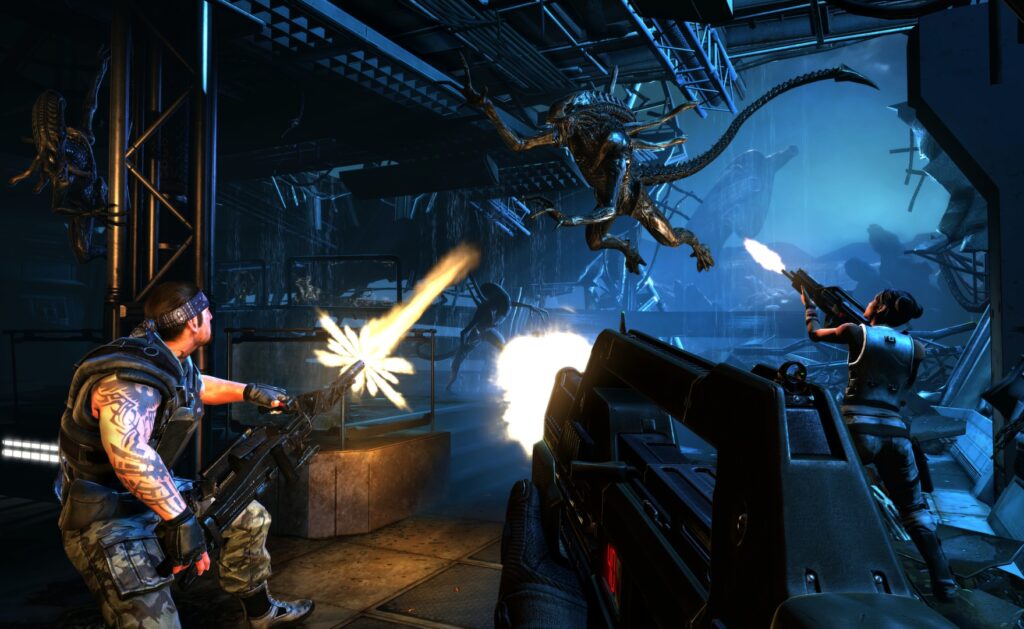
Aliens: Fireteam Elite Review Pros and Cons
From YouTuber Nick930:
Fireteam Elite on the other hand is a third-person shooter built to play more like a hybrid of Gears of War and World War Z. While this is generally a good choice for a game that wants to show off its lead character design, I don’t see the reason for it in this particular title. Sure, you can customize your character any way you want and equip him or her with vanity gear, that’s fun to see in-game but otherwise, this camera perspective is more of a hindrance than anything else. The claustrophobic level designs are not designed in a way that lends themselves to this type of player perspective and I found myself regularly fighting to see what I was aiming at and needing to swap shoulders and strafe as my allies did the same.
What I find even odder than this though, is the addition of the cover shooter mechanics. I have no clue why this feature is available in the game, it has no purpose when fighting swarms of enemies that are primarily melee-focused. There are ranged enemies like the pitter but its acid spit will create an area that bleeds through the cupboard that you’re hiding against. My guess is that there will be either human or android enemies in the later missions that will make taking cover more practical, but as it stands now the player is better off standing out in the open shooting from the hip to maximize the peripheral vision.
Fireteam Elite is a surpisingly fun experience.
So far from what we’ve discussed, it may seem like Fire Team Elite may not be as well-designed as Colonial Marines which would be one heck of achievement on its own, but that couldn’t be further from the truth once we get past all the issues that I’ve mentioned so far. Fireteam Elite is a surprisingly fun experience. We found ourselves wanting to go back and replay missions frequently and found that some mission parameters and enemy placement will change making each attempt feel slightly different and equipping things like challenge cards to modify that experience further just made it even more enjoyable. Before each mission, players can choose between four distinct classes: gunner, demolisher, technician, and dock. Within each of these classes, players can select between certain types of primary weapons perks and abilities each necessary to help push back the alien swarm. The gunner, for example, has access to the iconic pulse rifle along with a secondary shotgun and can activate a temporary increased fire rate for the entire team.
The demolisher can also use a pulse rifle but the secondary is limited to a heavier weapon like a smart gun, the technician and dock players are built more for their support role and can deploy objects to heal players or set up defensive perimeters. By carefully balancing these four unique classes, cooperative teams of up to three players can maximize their efficiency and pop Xeno heads in the most satisfying way possible. This, of course, contrasts heavily with Colonial Marines that tacked on its co-op mode without any regard for the game’s bouncing at all. It’s built primarily to be a single-player game, a short 6-hour single-player game, and instead of having different classes and all that the player instead can just access a weapon wheel and choose any weapon they want. Though most of the time the pulse rifle and shotgun are the only ones worth using, and cooler weapons like the flamethrower or the smart gun are delegated to specific moments during certain missions with no way to replenish their ammunition.
As far as weapon customization goes, Fire Team Elite offers a lot more options. In both games, players can equip things like barrels, muzzles, and scope attachments, along with cosmetic skins and decals to show them off, but there are much more practical attachments in Fire Team Elite that allow players to properly fine-tune their combat experience to suit their style. The attachments in Colonial Marines aren’t nearly as balanced; the laser sight and extended mags are nice, but long-range scopes and suppressors feel useless against aliens and human enemies alike except in a few very rare instances. Speaking of which, let’s talk a little bit about the enemies themselves. While the main enemy in both games is of course the xenomorph, there’s a lot of variety mixed in to make the combat more interesting in Colonial Marines.
The most common enemy you’ll run into is the Xeno soldier, a light and fast alien capable of running along walls and rushing the player with melee attacks. To add more range to the combat, players and also need to contend with spitters that can shoot acid from distances. Then there’s the Xeno boiler, identified by its green markings that can rush the player and explode. Fireteam Elite features a lot of the same enemy types who happen to serve more or less the same purpose and there are the soldiers known as runners here. The drones and prowlers that are like the lurker are designed to ambush the player and there are even the exploding bursters and spitters now and again, but Fire Team Elite also includes much more powerful Xenos called warriors.
Usually, during the bigger survival sections, this type of alien does technically appear in Colonial Marines, but it serves only as a single boss encounter instead now. There are still a few more campaigns in Fireteam Elite that could potentially introduce even more enemy types, so we’ll just have to wait and see. I wouldn’t be surprised if there were also face-huggers, androids, and an alien queen as well.
Conclusion
From YouTuber Nick930:
Finally, let’s wrap up this early preview comparison with a brief sound analysis for this section. I’ve chosen a few sequences from each game that I feel match pretty closely in terms of their relative action. I’ll be sure to create more controlled sound comparisons when the final game releases. Which game do you feel nails the general look sound and feel of the aliens’ experience?
It seems to be suffering the same identity crisis that Colonial Marines suffered from nearly a decade ago and fails to truly represent its source material to its full potential. Aliens is about a lot more than just gunning down swarms of bugs crawling on the ceiling. There’s a character to that world coupled with social commentary themes that all contribute to the overall style and atmosphere. But as it stands, the Fireteam Elite’s dismissive story delivery and lackluster presentation leave a lot to be desired. All of this could potentially be forgiven if the gameplay remains as enjoyable as it is.
Now, there’s something to be said about a game that’s fun to replay in harder difficulties that have not been done simply to grind for loot, and the game modifying challenge cards activated before each mission add a nice twist to the game’s replay value and are easily one of the game’s strongest aspects. But for most players, these types of things may not be enough to keep the game from becoming yet another disappointing Aliens video game spin-off and I feel as though some extra time to iron out all the bugs and integrate a more meaningful narrative would help immensely.
What do you guys think? Is a Fire Team Elite the Aliens game that you’ve been waiting for or is this potentially another Colonial Marines situation? Let us know in the comments section.
Screenshots
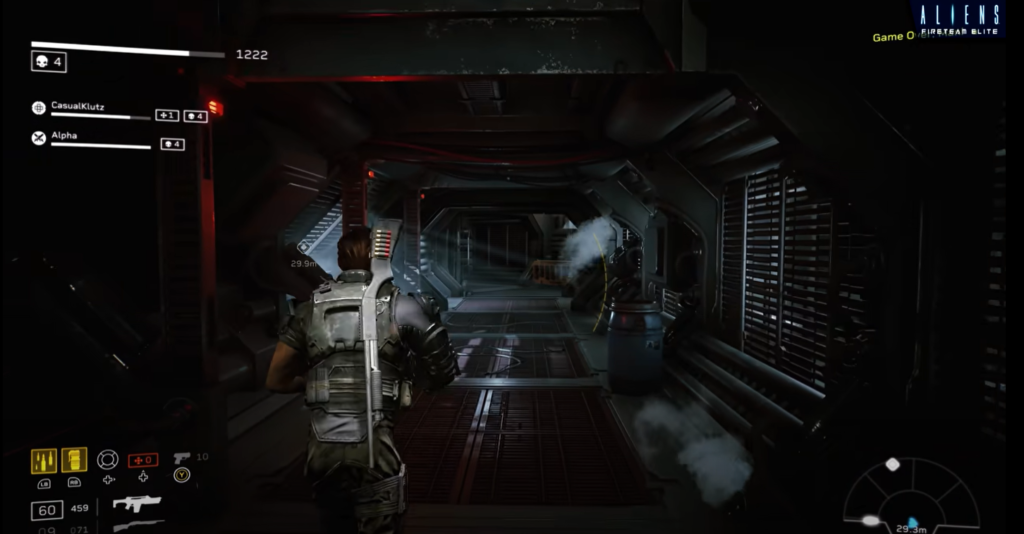
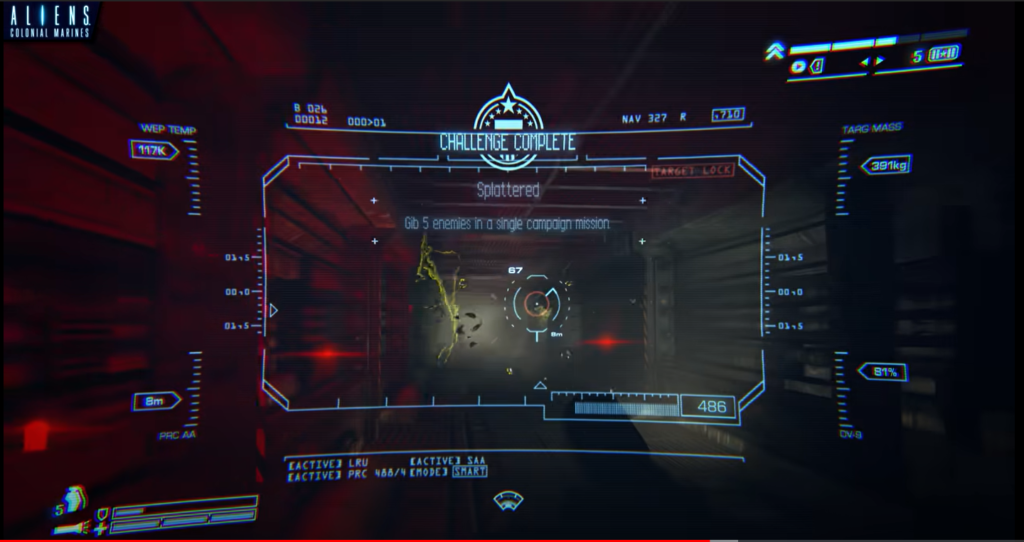
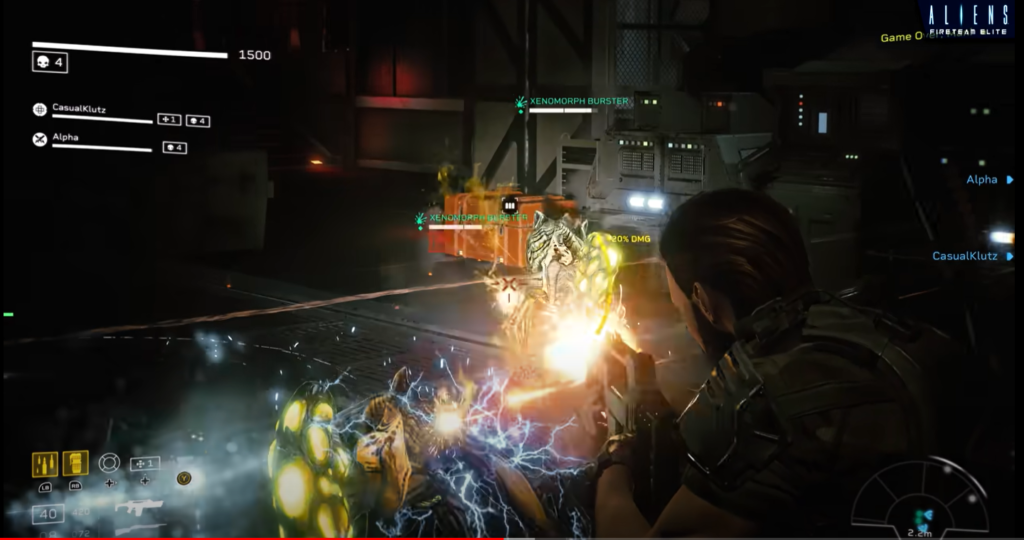
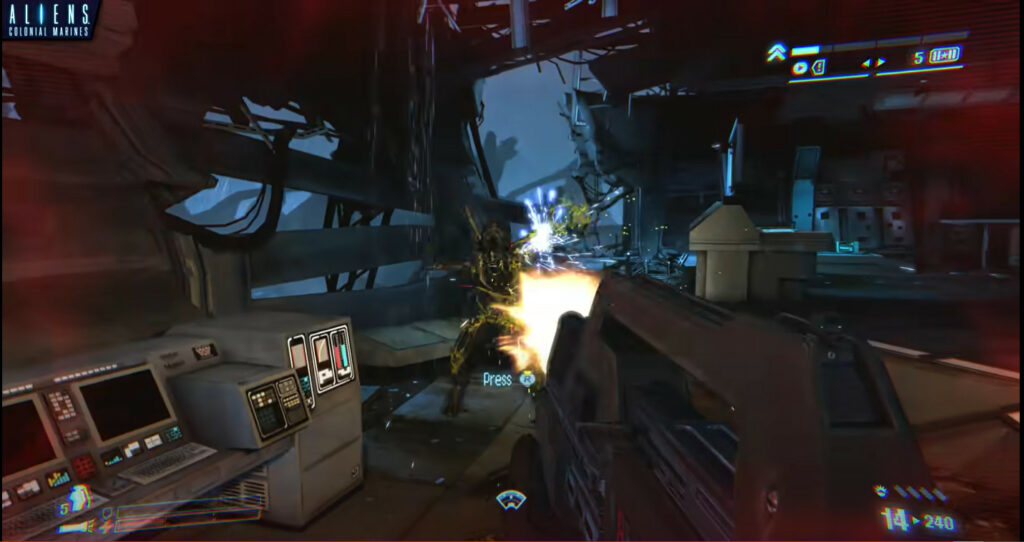
Credits
| Program | Founding Writers |
| Author | George C. |
| YouTuber | Nick930 |
| Publisher | MGN |
| Game | Aliens: Fireteam Elite |